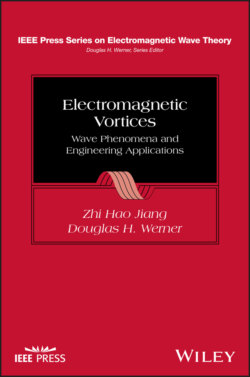Читать книгу Electromagnetic Vortices - Группа авторов - Страница 23
1.4 OAM Generation Methods
ОглавлениеThe history of OAM dates back in 1992, when Allen et al. showed that helically phased beams with a phase term ejlϕ carry OAM [3]. Since then, research efforts have focused on the generation of OAM beams. Figure 1.18 shows the analogy between the generation principle of OAM and conventional beams. In a conventional antenna system, a device (such as reflectors [22] and lenses [88]) is used to transform an input wavefront (for example, a spherical wavefront in Figure 1.18) into a planar wavefront, to achieve a highly directive beam in the far‐field. In analogy with the conventional antenna system, an OAM system employs an OAM device to transform the input wavefront into a spiral wavefront. Figure 1.19 shows a representative example where the wavefront‐transformation devices are a parabolic reflector [22] and a helicoidal reflector antenna [23], corresponding to the conventional and OAM cases, respectively. The conventional reflector antenna attempts to achieve a uniform phase in the exit aperture, whereas the helicoidal reflector aims to achieve the OAM vortex phase.
Figure 1.17 (a) Cross‐section of a 19‐ring multi‐OAM multi‐ring fiber. (b) Refractive index profile of a single ring. (c) Intensity and phase distributions of HE31 related OAM mode in a single ring.
Source: Li and Wang [75] © 2014 Springer Nature.
Figure 1.18 Analogy between conventional and OAM generation principle.
The generation of OAM‐carrying beams necessitates the design of antennas that can generate the vortex aperture phase and spiral wavefront that are associated with OAM beams. Some representative designs that have been developed for this purpose are shown in Table 1.1. The spiral phase plate (SPP) has one planar and one spiral surface with a step discontinuity, and the thickness increases as the azimuth angle increases [13, 19,89–91]. The original shape of the conventional parabolic reflector is modified to form a ‘helicoidal reflector’ [23] that converts the field generated by a feed into an OAM‐carrying field [92–94]. A stepped spiral reflecting surface is a discrete approximation of the helicoidal reflector [101]. Planar SPPs, transmitarray [95–100], and reflectarray antennas [5,114–117] employ elements that are distributed in planar surfaces; these elements compensate the phase delay associated with incident waves from different paths emitted from the feed and generate the desired vortex phase distribution. The uniform circular array (UCA) consists of elements that are uniformly distributed on the circumference of a circle. The array elements are fed with an input signal with the same amplitude but with a successive phase delay from element to element such that after a full turn the phase has been incremented by 2πl, where l is the OAM mode number [33, 62,102–109]. The transmittance functions of holographic gratings can also be designed to generate OAM beams [110–113]. Other generation methods include cylindrical lenses [3], spatial light modulators [9], q plates [118], dielectric resonators [119], traveling‐wave circular loops [120], and metasurfaces [121]. The previous designs can generate single‐mode OAM beams, superposition of OAM modes, i.e., mixed‐mode OAM beams [5, 95], and mode‐reconfigurable OAM beams [102, 121].
Figure 1.19 Comparison between the generation method of conventional antennas with directive far‐field patterns and OAM antennas: the case of reflector antennas.
